
   |
 |
|
|
|
Specie Specific: As mentioned, your ability
to attract a particular type of bird depends on multiple criteria.
The most important of course is whether or not your bird house
dimensions are specifically geared to the species you wish to
attract. Most people are surprised to
learn the types of birds that will not use a bird house, so before
you have visions of attracting you favorite wild birds, check out
this list of birds that will take you up on your offer. Ofcourse,
they can be very picky about where they stay and paying close
attention to their specific needs is crucial to your success, and
theirs.
BIRDS YOU CAN ATTRACT TO NEST BOXES Many of the birds that visit feeders and baths may stay and nest in nearby trees. Most of them, including cardinals, doves and orioles, don't nest in boxes. You can still help them by considering their food and shelter requirements in your landscape plans. You can also hang out a wire cage full of nesting materials (fiber scraps, twigs, wool, or feathers) in the spring. More than two dozen North American birds will nest in bird houses. The
following descriptions will help you determine which birds might visit
your neighborhood.
Bluebirds have problems with other animals too. The easiest way to
discourage predatory cats, snakes, raccoons, and chipmunks is to mount the
house on a metal pole, or use a metal predator guard on a wood post.
Chickadees, Nuthatches, and TitmiceChickadees, titmice, and nuthatches share the same food, feeders, and habitats. If you put a properly designed nest box in a wooded yard, at least one pair is sure to check it out. Put chickadee houses at eye level. Hang them from limbs or secure them to tree trunks. The entrance hole should be 1-1/8" to attract chickadees yet exclude house sparrows. Anchor houses for hatches on tree trunks five to six feet off the ground. You can encourage these birds to stay in your yard by continuing to
fill your suet and peanut feeders through the summer.
WrensWrens don't seem to be very picky about where they nest. Try nest boxes with a 1" x 2" horizontal slot (1-1/2" x 2-1/2" for the larger Carolina wrens) instead of a circle. These are easier for the wrens to use. Wrens are notorious for filling up any conceivable nest cavity with
twigs, regardless of whether they use the nest. Since male house wrens
build several nests for the female to choose from, hang several nest boxes
at eye level on partly sunlit tree limbs. Wrens are sociable and will
accept nest boxes quite close to your house.
Violet-green swallows nest in forested mountains of the west; boxes
placed on large trees in a semi-open woodland will attract them.
Purple MartinsMany people want martins because, it's been said, these birds "can eat 2,000 mosquitoes a day." While it's true that they eat flying insects, don't expect purple martins to wipe out your mosquitoes. Martins actually prefer dragonflies, insects which prey on mosquito larvae. Mosquitoes are most active after sunset. If you want to rid your yard of mosquitoes, put up a bat roosting box. One bat can eat thousands of mosquitoes a night. But don't cross martins off your prospective tenant list because they don't live up to their "bug zapping" reputation. If you need a reason for attracting them, these gregarious swallows put on a show that's better than any television soap opera. You have the best chance of attracting martins if you put a house on the edge of a pond or river, surrounded by a field or lawn. Martins need a radius of about 40 feet of unobstructed flying space around their houses. A convenient wire nearby gives them a place to perch in sociable groups. Martins nest in groups, so you'll need a house with a minimum of four large rooms -- 6 or more inches on all sides, with a 2-1/4 inch entrance hole about an inch and a half above the floor. Ventilation and drainage are critical factors in martin house design. Porches, railings, porch dividers and supplemental roof perches, like a TV antenna, will make any house more appealing. Gourds may also be made into houses by making an entrance hole and providing drainage. If you use gourds, it's not necessary to add railings and perches. Adult martins will perch on the wire used to hang the houses. Before you decide on a house, take the time to think about what kind of pole you're going to put it on. Martins will occupy a house that's between ten and twenty feet off the ground. Some poles are less cumbersome than others. Gourd houses are the easiest to set up. You can string them:
Light-weight aluminum houses can be mounted on telescoping poles, providing easy access for maintenance and inspection. Because of their weight (well over 30 pounds), wood houses cannot be mounted on easy-access telescoping poles. You'll have to use a sturdy metal or wood pole attached to a pivot post. The problem with this "lowering" technique is that you can't tilt the house without damaging the nests inside. If you put your house on a shorter, fixed pole, ten to twelve feet high, you can use a ladder to inspect and maintain it. FlycatchersThe great crested flycatcher and its western cousin, the ash-throated flycatcher, are common in wooded suburbs. Their natural nesting sites are abandoned woodpecker holes. These flycatchers may nest in a bird house if it's placed about ten
feet up in a tree in an orchard or at the edge of a field or stream.
For best results, place the box high up on a tree trunk exposed to
direct sunlight.
Barn owls are best known for selecting nesting sites near farms. Where trees are sparse, these birds will nest in church steeples, silos, and barns. If you live near a farm or a golf course, try fastening a nest box about 15 feet up on a tree trunk. Screech owls prefer abandoned woodpecker holes at the edge of a field or neglected orchard. They will readily take to a boxes lined with an inch or two of wood shavings. If you clean the box out in late spring after the young owls have fledged, you may attract a second tenant--a kestrel. Trees isolated from larger tracts of woods have less chance of squirrels taking over the box. After you have done your homework as to the birds in your area and the type of bird houses that will attract them, it is time to figure out the best place to situate your bird house.
|
 Bird House Guard
Bird House Guard
Description: 7/8" Natural Cedar w/fully routed edges. 1-1/2" or 1-1/4" Hole. Comes with 2 mounting screws. Dimensions: 3-1/4" L x 3-1/4" H  |
 Bluebird House w/Viewing Window
Bluebird House w/Viewing Window
Description: 7/8" Inland Red Cedar w/green or burgundy roof for long lasting outdoor use. All screwed construction using weather-resistant plated deck screws and fully routed edges. Overhang roof, vents and drainage holes keep nest dry and cool. Predator-resistant entrance hole. Front wall screen helps chicks climbing to the entrance hole. Side-opening door with plexy insert for viewing removes for easy cleaning. Comes with mounting screws. Dimensions: 9" L x 7-3/4" W x 14" H  |
 Bluebird House
Bluebird House
Description: 7/8" Inland Red Cedar for long lasting outdoor use. All screwed construction using weather-resistant plated deck screws and fully routed edges. Overhang roof, vents and drainage holes keep nest dry and cool. Predator-resistant entrance hole. Front wall screen helps chicks climbing to the 1-1/2" or 1-9/16" entrance hole. Side door opens for easy cleaning. Comes with mounting screws. Dimensions: 8-1/2" L x 7-1/4" W x 15-3/4" H  |
 Heartwood Summer Home - Prepack of five Birdhouse
Heartwood Summer Home - Prepack of five Birdhouse
Wrens, chickadees, nuthatches, titmice--this little beauty is beloved by all your favorites, and with reinforced front you'll never have to worry about unwanted guests. Select cypress construction with Heartwood's special hand-cut and stone-washed shingle roof gives it exceptional style; copper covered cleanout door and metal hanger make for exceptionally easy maintenance. Sold in a 5-pack, one each of these great colors: whitewashed, pinion green, redwood, smoke gray and celery. Dimensions: 5" x 8" x 9" - 1-1/4" hole  |
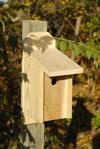 Heartwood Western Bluebird Joy Box Birdhouse
Heartwood Western Bluebird Joy Box Birdhouse
John James Audubon did some of his most famous bird drawings as he explored on foot along the Natchez Trace, which happens to be located near Star, Mississippi, where we design and make all our Heartwood homes. While birding has come a long way since Audubon's time, today with our four-season nesting boxes and basic homes, you don't need to go to anywhere to enjoy all manner of wonderful bird life flocking to your door. Discreet complements to any landscape, these hardy havens are convenient, long lasting and beautiful-the picture perfect start to your life in birding! Season after season, this delightful nesting box is a joy to behold and a breeze to maintain thanks to easy twist latch and slide-front panel that also inverts for winter roosting. So easy to use, so easy to love, it turns birding into child's play! Rugged construction features 13/16" solid cypress and headed ring shank stainless steel nails. Dimensions: 6 ½" x 10" x 17"; 1 9/16" hole  |
 Heartwood Wren Joy Box Birdhouse
Heartwood Wren Joy Box Birdhouse
Why get complicated? Season after season, this delightful nesting box is a joy to behold and a breeze to maintain thanks to easy twist latch and slide-front panel that also inverts for winter roosting. So easy to use, so easy to love, it turns birding into child's play! Rugged construction features 13/16" solid cypress and headed ring shank stainless steel nails.  |
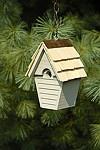 Heartwood Wren in the Wind Birdhouse
Heartwood Wren in the Wind Birdhouse
"I realized that if I had to choose, I'd rather have birds than airplanes," great American aviator Charles Lindberg said. Fortunately, we can all enjoy both, and with the eyehook for easy hanging, the graceful Wren in the Wind will double as a spectacular air show--takeoffs and landings all day long! Made with solid cypress, featuring copper trim, drainage, ventilation and rear panel cleanout. Dimensions: 6" x 8" x 12" - 1-1/8" hole  |
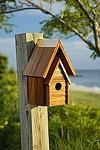 Heartwood Wrental House Birdhouse
Heartwood Wrental House Birdhouse
We could all take a lesson from the wren. In a typical day, the male wren may make up to 1,000 trips to and from the nest to feed his young, stopping regularly to burst into song. A bird like that deserves a house this fine, with all the great features of our Starter Home--solid mahogany, hand-oiled, with a hanging loop on the back--along with an A-line reinforced front. Our "A+" effort for a bird that teaches us joy! Dimensions: 6" x 7" x 11" - 1-1/4" hole  |
 Recycled Bluebird House
Recycled Bluebird House
Description: 5/8" Poly-lumber made from recycled plastic and milk jugs; lifetime guarantee to never crack, split or fade. Taupe base w/blue roof. Stainless steel screws. Side-opening door for easy cleaning. Front wall screen helps chicks climbing to the entrance hole. Predator-resistant 1-1/2" entrance hole and overhang roof. Mounting screws included. Dimensions: 6-5/8" L x 8" W x 12-5/8" H   |
 Recycled Ultimate Bluebird House w/Camera
Recycled Ultimate Bluebird House w/Camera
Description: 5/8" Poly-lumber made from recycled plastic and milk jugs; lifetime guarantee to never crack, split or fade. Taupe base w/blue roof. Stainless steel screws. Opening side doors engraved with "clean" and "view". "View" door opens to a plexy glass viewing window. House has a raised screen floor to reduce blowfly infestations. Front wall screen helps chicks climbing to the entrance hole. Predator-resistant 1-1/2" entrance hole. Overhang roof, vents and drainage holes keep nest dry and cool. Mounting screws included. Comes with camera and 100' of cord that connects to your television to watch the nest. Dimensions: 11" L x 8-1/2 " W x 12-5/8" H   |
 Recycled Ultimate Bluebird House w/Viewing Window
Recycled Ultimate Bluebird House w/Viewing Window
Description: 5/8" Poly-lumber made from recycled plastic and milk jugs; lifetime guarantee to never crack, split or fade. Taupe base w/blue roof. Stainless steel screws. Opening side doors engraved with "clean" and "view". "View" door opens to a plexy glass viewing window. House has a raised screen floor to reduce blowfly infestations. Front wall screen helps chicks climbing to the entrance hole. Predator-resistant 1-1/2" entrance hole. Overhang roof, vents and drainage holes keep nest dry and cool. Comes with mounting screws. Dimensions: 11" L x 8-1/2" W x 12-5/8" H   |
 Recycled Wren House
Recycled Wren House
Description: 5/8" Recycled poly lumber w/taupe base, green roof, flat plexy bottom, stainless steel screws, and hanging cable. Poly-lumber made from recycled plastic and milk jugs, lifetime guarantee to never crack, split or fade. Dimensions: 9" L x 7" W x 7-1/2" H w/hanging cable 16" H   |
 Small Wren House
Small Wren House
Description: 7/8" Inland Red Cedar for long lasting outdoor use. All screwed construction using weather-resistant plated deck screws and fully routed edges. Overhang roof, air vents, and drainage holes. Side-opening door. Entrance hole sized for wrens. Can be hung or mounted. Comes with mounting screws. Dimensions: 9-3/4" L x 6-1/4" W x 7" H  |
 Standard Bluebird House
Standard Bluebird House
Description: 7/8" Inland Red Cedar for long lasting outdoor use. All screwed construction using weather-resistant plated deck screws and fully routed edges. Overhang roof, vents and drainage holes keep nest dry and cool. Predator-resistant entrance hole. Front wall screen helps chicks climbing to the 1-1/2" or 1-9/16" entrance hole. Side door opens for easy cleaning. Comes with mounting screws. Dimensions: 8-1/2" L x 7-1/4" W x 15-3/4" H  |
 Ultimate Bluebird House w/Viewing Window
Ultimate Bluebird House w/Viewing Window
Description: 7/8" Inland Red Cedar for long lasting outdoor use. All screwed construction using weather-resistant plated deck screws, aluminum rust-resistant continuous hinges, and fully routed edges. Opening side doors engraved with "clean" and "view". "View" door opens to plexy insert for viewing. House has a raised screen floor to reduce blowfly infestations. Copper portal guard, 1-1/2" hole, vents and drainage holes, and long overhang. Comes with mounting screws. Dimensions: 7" L x 8-3/4" W x 15" H  |
 Wren House
Wren House
Description: 7/8" Inland Red Cedar for long lasting outdoor use. All screwed construction using weather-resistant plated deck screws and fully routed edges. Green or burgundy stained roof. Side-opening door, overhang roof, and air vents. Hole sized for wrens. Can be hung or mounted. Dimensions: 10-1/2" L x 7" W x 10" H  |
 Acorn Bird Product - All Bird Cafe
Acorn Bird Product - All Bird Cafe
9" x 17". Pole Not Included. |
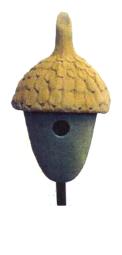 Acorn Bird Product - Bluebird Chateau
Acorn Bird Product - Bluebird Chateau
9" x 17". Pole Not Included. |
 Acorn Bird Product - Chickadee Inn
Acorn Bird Product - Chickadee Inn
9" x 17". |
 Acorn Bird Product - Just Plain Nuts
Acorn Bird Product - Just Plain Nuts
6" x 12". |
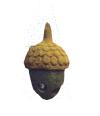 Acorn Bird Product - Nuthouse Cafe
Acorn Bird Product - Nuthouse Cafe
6" x 12". |
 Acorn Bird Product - Nuthouse
Acorn Bird Product - Nuthouse
6" x 12". |
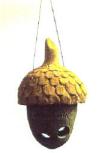 Acorn Bird Product - Suet Feeder
Acorn Bird Product - Suet Feeder
6" x 12". |
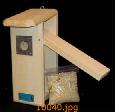 Coveside Downy Woodpecker House
Coveside Downy Woodpecker House
America's smallest woodpecker, the Downy is a
backyard favorite. They are friendly little birds that
enjoy being around people. Since Downys tend to use nest boxes in the winter as
roosts to escape the cold, one might want to put up a house in the fall. Comes
standard with slate squirrel guard and wood chips. |
|
Ads by Google |

Home
Page |
Product Review Page | Help
 Woodside Gardens
The Registry of Nature Habitats
Woodside Gardens
The Registry of Nature Habitats 
 1999 -
1999 -
All Rights Reserved
Last Updated: